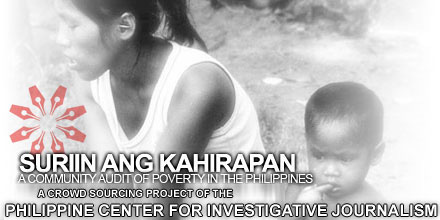
Even worse, the Philippines reportedly has one of the highest levels of income inequality in Asia. The income of 30 out of 100 Filipinos falls far short of the minimum cost of satisfying basic requirements, and live below the poverty threshold. In the most impoverished provinces, the delivery of basic services remains grossly inadequate and effete. The lack of checks and balances, and the dismal participation of citizens in government affairs, have also further weakened their capability to address pressing concerns.
The state-run National Statistical Coordination Board (NSCB) lists in its 2003 report that of the country’s 83 provinces, the following are the poorest: Zamboanga del Norte, Maguindanao, Masbate, Surigao del Norte and Agusan del Sur.
The web site at http://www.i-site.ph/povertyaudit/ is part of the project “Suriin ang Kahirapan: A Community Audit of Poverty in the Philippines” which was initiated by the Philippine Center for Investigative Journalism (PCIJ) with generous support from the Philippine-Australian Community Assistance Program (PACAP).[1]
Suriin aims to monitor the implementation of development programs in the five poorest provinces in the Philippines, from the point of view of community stakeholders.
Through crowd-sourcing, an offshoot of the “citizen journalism” movement, PCIJ tracks the issues, programs and factors that facilitate or impede the delivery of basic services and implementation of programs by local government units (LGUs).
Through their participation in the project, PCIJ seeks to encourage the community to be more aware and critical of the development programs of their LGUs, particularly in the key areas of poverty, education and health.
The project not only aims to monitor government initiatives but also civil society initiatives, highlighting best practices and analyzing the problems they encounter.
We invite you to explore the site and be informed of how our countrymen in the five poorest provinces are faring. SURIIN is a valuable resource center on the development situation of each province, focusing on following: development and poverty alleviation programs (i-File); poverty indicators vis a vis the Millennium Development Goals (Tracking Poverty); financial highlights, IRA allotment and other funds (The Money Trail); and the leaders and their profiles (Who’s Who).
Welcome and help us, SURIIN ANG KAHIRAPAN.
Related articles:
 Home | Aims and Objectives of Solidarity Philippines Australia Network | About Kasama
Home | Aims and Objectives of Solidarity Philippines Australia Network | About Kasama 
Search the SPAN Web